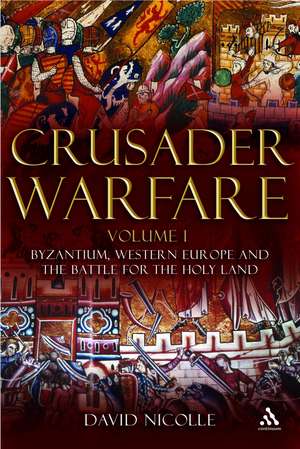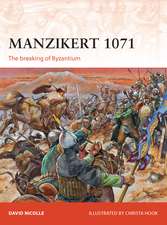Crusader Warfare Volume I: Byzantium, Western Europe and the Battle for the Holy Land
Autor Dr David Nicolleen Limba Engleză Hardback – 14 mai 2007
This book presents as many aspects as possible of warfare during the period of the crusades within all the cultures most directly involved. To a large extent the current interest in the Crusades reflects the perceived threat of a so-called "clash of civilisations". While warnings of such a supposed clash in our own times are based upon a misunderstanding of the natures of both "Western" and "Islamic" civilisations, some commentators have looked to the medieval Crusades as an earlier example of such a clash. In reality they were no such thing. Instead the Crusades resulted from a remarkable variety of political, economic, cultural and religious factors. The Crusades, even excluding the Northern or Baltic Crusades, also involved an extraordinary array of states, ruling dynasties, ethnic or linguistic groups and the fighting forces associated with these disparate participants.
This volume focuses on Western Europe and the Byzantium Crusades. Latin or Catholic Europe certainly had an "eastern front". Medieval Europeans, and certainly the knightly class which came to bear the brunt of Crusading warfare, would have seen all these fronts as part of Latin Christendom's struggle against outsiders. The latter ranged from infidels to schismatics, to pagans and other "enemies of God". Excluding Crusading or Christian frontier warfare north of the Carpathian Mountains did not reflect any real military or even political factors on the Latin side of the "front". It is based upon which enemies were to be included and which excluded.
This study looks at Christian and in a few cases "pagan" armies whose actions or mere existence in sub-Saharan Africa and Central Asia, had a bearing upon military, political and economic relations between Christendom and Islam within the Mediterranean world.
This volume focuses on Western Europe and the Byzantium Crusades. Latin or Catholic Europe certainly had an "eastern front". Medieval Europeans, and certainly the knightly class which came to bear the brunt of Crusading warfare, would have seen all these fronts as part of Latin Christendom's struggle against outsiders. The latter ranged from infidels to schismatics, to pagans and other "enemies of God". Excluding Crusading or Christian frontier warfare north of the Carpathian Mountains did not reflect any real military or even political factors on the Latin side of the "front". It is based upon which enemies were to be included and which excluded.
This study looks at Christian and in a few cases "pagan" armies whose actions or mere existence in sub-Saharan Africa and Central Asia, had a bearing upon military, political and economic relations between Christendom and Islam within the Mediterranean world.
Preț: 395.08 lei
Preț vechi: 614.90 lei
-36% Nou
Puncte Express: 593
Preț estimativ în valută:
75.61€ • 78.64$ • 62.42£
75.61€ • 78.64$ • 62.42£
Carte tipărită la comandă
Livrare economică 14-28 aprilie
Preluare comenzi: 021 569.72.76
Specificații
ISBN-13: 9781847250308
ISBN-10: 1847250300
Pagini: 320
Ilustrații: 8
Dimensiuni: 156 x 234 x 30 mm
Greutate: 0.64 kg
Editura: Bloomsbury Publishing
Colecția Hambledon Continuum
Locul publicării:London, United Kingdom
ISBN-10: 1847250300
Pagini: 320
Ilustrații: 8
Dimensiuni: 156 x 234 x 30 mm
Greutate: 0.64 kg
Editura: Bloomsbury Publishing
Colecția Hambledon Continuum
Locul publicării:London, United Kingdom
Caracteristici
The first volume of a book that looks to broaden our understanding of the Crusades and their participants.
Cuprins
Introduction
Western Europe and the Crusader States
Byzantium and the Orthodox Christian States
The Military Heritage and Impact of Crusading Warfare
Terminology
Bibliography
Recenzii
Mentioned in The Historian, October 2009

















